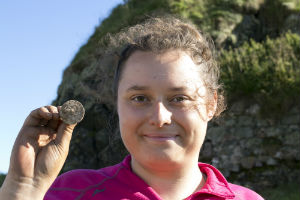Spectacular find marks a moment of history at Dunyvaig Castle
29 August 2018

Archaeologists have brought back to life a key moment in the turbulent history of Dunyvaig Castle on the Isle of Islay by finding a precious item belonging to one of its former occupiers.
The seal of Sir John Campbell of Cawdor (c. 1576-1642), who had taken ownership of Islay in 1615, was discovered by an undergraduate working at the University of Reading’s ongoing annual summer school dig on the island.
The seal had lain on a clay floor within the castle for more than 400 years, buried below mounds of rubble from the collapsed defensive wall. Once used to sign and seal charters and legal documents, it is a circular disc of lead, carrying the inscription IOANNIS CAMPBELL DE CALDER [Calder was the original spelling of Cawdor]. The seal carries the Cawdor coat of arms with a galley-ship and a stag. On its reverse, is the date of 1593 and the initials DM.
The Campbells and MacDonalds fought over Dunyvaig in the early 17th century, with a series of sieges and bombardments of the castle until the Campbells finally prevailed.
Zoë Wiacek, the University of Reading student who found the seal, said: “I removed a piece of rubble and it was just sitting there on the ground. I immediately knew it was an important find, but had no idea what it was. I called over my trench supervisor, and when it was lifted, the soil fell away to show the inscription. Then everyone became excited. I am so proud to have found something so important for the project and for Islay.”
Undertaken by Scottish charity Islay Heritage and the University of Reading, the 2018 Dunyvaig excavation continues until Friday 31 August. It will resume in 2019 to continue unveiling the history of Dunyvaig.
Islay Heritage aims to help the local community embrace the ownership of the heritage of the island and better present it to a wider audience, including tourists and schools. The annual summer schools also allow University of Reading students to get first hand experience of an archaeology investigation.
Dr Darko Maričević, Director of the Excavation, said: “This is a remarkable find. Not only is it a beautiful and well-preserved object, but it comes from the floor of a building that we can now confidently date to the Campbell occupation. So buried below this floor, we will have the story of the MacDonald’s – the Lords of the Isles – to reveal.”
Roddy Regan, of Kilmartin Museum, said: “Seals are extremely rare finds. This discovery conjures up an image of a Campbell garrison fleeing from the castle when under attack, dropping and losing one of their most precious items, or maybe the seal had once been hidden within a wall niche and long forgotten.
“Perhaps the raid was in 1646, when Alasdair MacColla, a descendent of the MacDonalds, retook the castle and installed his elderly father, Colla Ciotach to defend it. The castle was immediately besieged again. We may have Colla Ciotach’s hasty defences in the form of turf walls built above the already ruined stone walls of Dunyvaig, before he was forced to surrender in 1647 and then hanged from the castle walls.”
Professor Steven Mithen, Professor of Archaeology at the University of Reading, Chairperson of Islay Heritage and Director of the Dunyvaig Project, has been involved in research on Islay for more than 30 years and helped establish the Islay Heritage charity in 2016.
He said: “Coming towards the end of the dig, after the team had worked so hard to move huge amounts of turf and rubble, this has been a thrilling discovery. We have found a piece of Islay’s past and Scottish history. We can’t wait to start digging again in 2019.”
